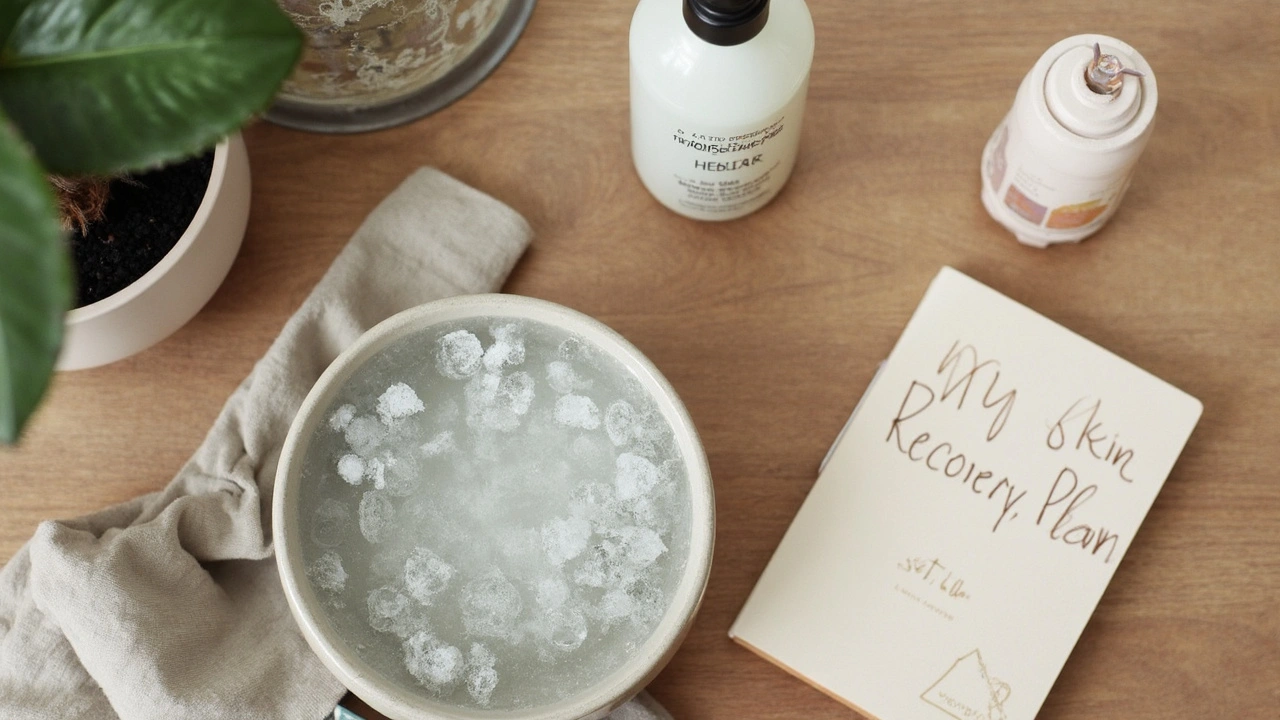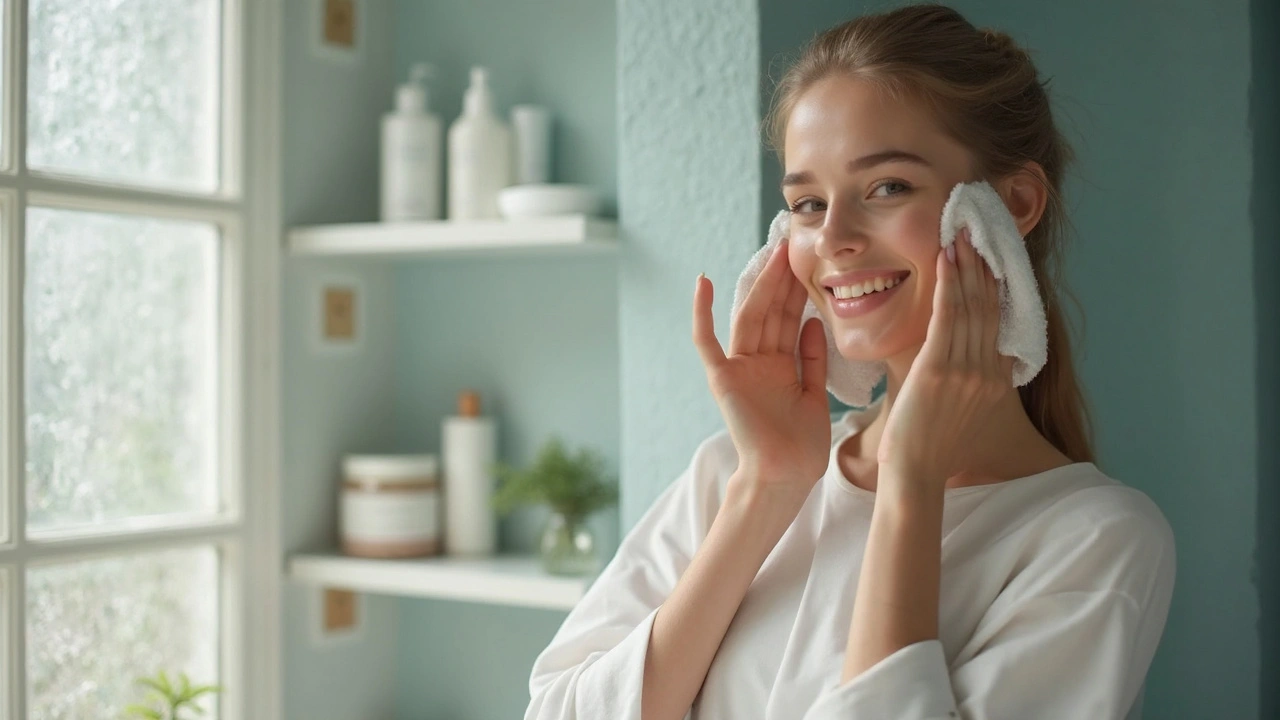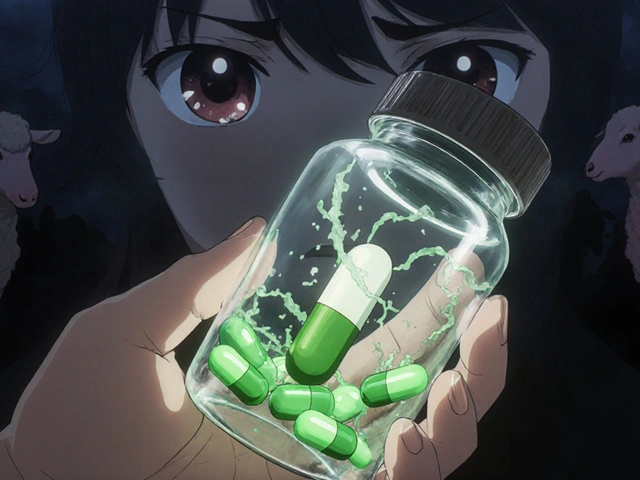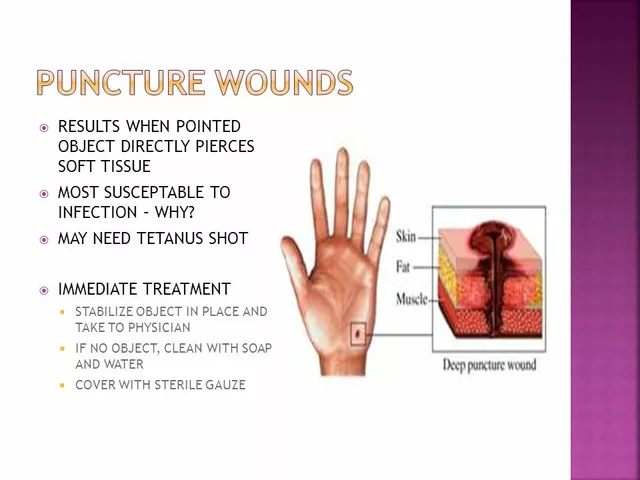You wake up with red patches or itchy bumps and wonder what’s set your skin off this time. Sound familiar? Skin irritation feels random, but there’s often a pattern hiding behind it—usually in your daily skincare routine (or lack of one).
Most people don’t think twice about the soap they use or how often they scrub their face. But skipping a gentle routine or using harsh products can tear up your skin’s natural barrier, making it more likely you'll end up with rashes, dry spots, or that tight, stingy feeling no one loves.
Small changes add up. Switching from scented cleansers to fragrance-free options, using moisturizer after every wash, and dodging grainy exfoliators can seriously calm things down. You don’t need a shelf full of fancy bottles—sometimes, less is more. Noticed that your skin gets worse after hot showers or certain creams? That’s your sign to rethink your habits.
- Why Skin Gets Irritated in the First Place
- Daily Routines That Actually Help
- What to Avoid If You Have Sensitive Skin
- When to See a Pro (and What to Expect)
- Real-Life Tips for Calmer, Happier Skin
Why Skin Gets Irritated in the First Place
Ever wonder why your skin throws a fit over what looks like nothing? The main job of your skin is to protect you against outside stuff—dust, pollution, bacteria, even the weather. But that shield isn’t bulletproof. When you use the wrong products or take super hot showers, that natural barrier can get damaged. Suddenly, things that never bothered you before start causing skin irritations.
Common triggers aren’t just harsh chemicals—think fragrances in soaps, alcohol in toners, or rough scrubbing that strips away your skin’s natural oils. Even something as simple as changing laundry detergent can set off redness and itching if you’ve got sensitive skin.
- Allergens: Ingredients like fragrance or certain preservatives can cause a reaction if you’re sensitive.
- Climate: Super dry or cold weather can zap moisture and weaken your skin’s defense.
- Friction: Over-washing, rubbing with towels, or wearing tight clothing turns mild irritation into a big problem.
- Underlying Skin Conditions: If you have eczema or psoriasis, your skin is already more reactive than most.
- Immune system: Sometimes, your own body overreacts to minor things, making simple bumps snowball into full-blown rashes.
If you look at recent numbers pulled from dermatology visits, up to 50% of people say they’ve had skin irritations in the last year. Younger people are actually reporting more problems as trends like over-exfoliation (thanks, social media hacks) gain popularity.
| Common Trigger | How Often It Causes Irritation (%) |
|---|---|
| Harsh cleansers | 38% |
| Fragrances in products | 25% |
| Weather changes | 21% |
| Over-washing/exfoliating | 16% |
| Detergents/household cleaners | 12% |
So, it’s not just bad luck. Think of your skincare routine as your first line of defense. If something keeps setting your skin off, it’s probably worth looking at your daily habits and seeing if there’s a culprit hiding in plain sight.
Daily Routines That Actually Help
Getting the basics right in your skincare routine is half the battle when it comes to managing skin irritations. You don’t need a bunch of expensive products, but you do need to be consistent and pay attention to what your skin reacts to every day. Here’s what actually makes a difference:
- Gentle Cleansing: Pick a fragrance-free, non-foaming cleanser. Most people think squeaky clean is good, but over-washing strips your skin's protective oils, which can make dryness and irritation much worse. Washing your face twice a day (morning and night) is enough.
- Moisturizing Right After Washing: Pat your face dry—not rub, since tugging can cause more irritation—then put on a good moisturizer while your skin’s still damp. This helps lock in moisture and repair your skin’s barrier. Look for products with ceramides or hyaluronic acid—they’re proven to help with hydration and barrier repair.
- Sunscreen—Even Indoors: UV rays can sneak through windows and worsen redness and irritation. Choose a mineral sunscreen (zinc oxide or titanium dioxide) because they’re usually gentler for sensitive or reactive skin.
- Don’t Skip Patch Tests: Trying out a new product? Test a little on the inside of your forearm for a day or two before using it on your face. It’s simple but saves a lot of heartbreak.
- Cool Down After Showers: Hot water feels great but dries out the skin fast. Keep shower temps lukewarm and try to keep them short. As soon as you’re out, moisturize to avoid that tight, uncomfortable feeling.
- Hands Off!: Scratching or picking can break the skin and make irritation worse. If you’re dealing with itchy patches, try pressing a clean, cool cloth on them instead.
Check out this quick cheat sheet. These tweaks seriously boost your skin’s chance of staying calm:
| Routine Step | Why It Matters |
|---|---|
| Gentle Cleansing | Removes dirt without stripping skin's natural oils |
| Moisturizing | Repairs protective barrier and locks in water |
| Sunscreen | Shields from UV, which can trigger more irritation |
| Patch Testing | Prevents major flare-up from new products |
| Lukewarm Showers | Prevents extra dryness and tightness |
Sticking with the right daily skin health habits can change everything for sensitive or irritated skin. It’s about working with your skin, not against it.

What to Avoid If You Have Sensitive Skin
If your skin flares up at the drop of a hat, you really want to watch out for certain triggers. The most common troublemakers are in your daily products and some habits you might not even notice.
- Fragranced skincare and soap: Anything that smells strong—think perfumes, “fresh” scents, or “natural” essential oils—can set off sensitive or irritated skin. Even “unscented” isn’t a safe bet unless it says “fragrance-free.”
- Alcohol-based cleansers or toners: These strip your skin’s moisture barrier. That stinging feeling after using toner? That’s usually alcohol.
- Exfoliating scrubs and brushes: If you can feel the grit, it’s probably too rough. Most people with sensitive skin do better skipping the scrubs altogether.
- Hot water: Long, hot showers or washing your face with steaming water dries out your skin faster than you’d think. Lukewarm is best.
- Certain preservatives and dyes: Parabens and artificial dyes are often found in skincare, especially cheaper products, and have been linked to higher rates of irritation.
- Heavy or oily creams: If you have breakouts on top of irritation, greasy creams can clog up pores and make things worse.
- Overdoing it: More is not always better—even if something says it’s for sensitive skin, layering too many products can cause reactions.
If you ever feel burning, stinging, or itching after trying something new, that’s a clear sign it’s not right for your routine. Stick to products labeled for sensitive skin and test new stuff on a small area first—like your jawline or behind your ear.
| Common Ingredient | Known to Cause |
|---|---|
| Fragrance | Itching, redness |
| Alcohol (denatured, SD alcohol) | Stinging, dryness |
| Sodium lauryl sulfate | Dryness, irritation |
| Essential oils (e.g., tea tree, peppermint) | Redness, burning |
One last tip: Don’t switch up your routine too often. Stick to what works and give your skin some stability. That’s your best shot at keeping skin irritations in check.
When to See a Pro (and What to Expect)
Sometimes, your skin irritations don’t get better no matter how careful you are with your skincare routine. If the itching, redness, or bumps stick around for over two weeks, seem to keep spreading, or start to hurt, it’s time to book an appointment with a dermatologist. Getting a pro involved isn’t overkill—it saves you time and stops the guessing game.
Here’s when you definitely shouldn’t wait:
- Rashes cover a big chunk of your skin.
- You notice open sores, yellow crust, or pus (infection alert!).
- Your skin irritation comes with fever, swelling, or you feel really unwell.
- At-home care doesn’t help after a couple of weeks.
Dermatologists see these problems all day, every day. At your appointment, expect questions about when symptoms started, products you use, your daily habits, and if this has happened before. Sometimes, doctors do a quick skin test where they gently scratch or tape your skin to check for allergies or infections—it’s painless, just a bit odd if you’ve never done it before.
Many people want to know how often these visits actually help. According to the American Academy of Dermatology, about 65% of folks who visit because of new skin reactions walk away with a new (and more accurate) diagnosis, which means the right treatment follows quickly.
| Sign | Should You See a Pro? |
|---|---|
| Redness or itching for 2+ weeks | Yes |
| Pain or oozing | Yes |
| Mild dryness or flakiness | Maybe (try at-home care first) |
| Skin irritations with fever | See a doc ASAP |
Once you get a diagnosis, treatment could be as simple as switching products or might involve prescription creams or oral meds. Sometimes, they’ll offer guidance for a new skincare routine that fits your situation. Either way, you leave knowing what to do next instead of trying random stuff and hoping for the best.

Real-Life Tips for Calmer, Happier Skin
Dealing with skin irritations is tough, but a few simple switches in your skincare routine can make a real difference. You don’t need to overhaul your whole life—just get consistent with habits that support your skin’s natural defenses.
- Stick to fragrance-free everything. Fragrances are one of the top triggers for sensitive skin and rashes. Even “natural” scents can be a pain, so grab products labeled “fragrance-free” (not just “unscented”).
- Moisturize right after washing. Damp skin soaks up moisturizers better, locking in moisture and helping your skin heal.
- Go easy on hot showers. Hot water strips your skin’s oils and dries it out fast. Stick with lukewarm water, and keep showers short (5–10 minutes).
- Check your laundry routine. Detergents with dyes and fragrances often irritate skin. A lot of people see big improvements just by swapping to a gentle, fragrance-free detergent.
- Simplify your product lineup. More isn’t always better. Too many products—especially those with alcohol, scrubbing beads, or strong actives—can spark flare-ups.
Here’s something most folks miss: your phone and pillowcase can mess with your skin too. Clean them regularly—bacteria builds up fast.
| Trigger | Simple Fix |
|---|---|
| Fragranced products | Switch to fragrance-free |
| Long, hot showers | Take shorter, lukewarm showers |
| Harsh cleansers | Try mild, non-foaming cleansers |
| Skipping moisturizer | Moisturize after washing |
| Dirty pillowcases | Change and wash weekly |
Also, take a look at your daily habits. Rubbing your face with a towel, scratching itchy spots, or using rough wipes can all crank up skin irritation. Instead, pat your skin dry gently, and resist the urge to scratch—hydrated skin usually itches less.
If you try these changes for a few weeks and your skin irritations still don’t budge, see a dermatologist. Sometimes, your skin needs a little extra help, like prescription creams or allergy testing. But for most people, sticking with basic, gentle, daily skincare routines gets real results.








Comments
Oh sure, just slap on any “miracle” cream and the government will stop the skin revolt.
Hey there, I totally get how frustrating those random red patches can be. It’s easy to feel like you’re guessing in the dark, but there are a few simple steps that actually work. First, opt for a fragrance‑free, non‑foaming cleanser and keep the washing to twice a day. Then, while your skin is still damp, lock in moisture with a ceramide‑rich cream – it really helps rebuild the barrier. Don’t forget to use a mineral sunscreen even when you’re indoors; UV rays love to sneak through windows. Lastly, always patch‑test new products on a small area before going full‑face. Hope this helps you calm the irritation without the drama.
Listen, sweetheart, you sound like you’re reading a glossy magazine written by a committee of bleached‑skin elites who think the world revolves around their scented lotions. The truth? Most of those “simple steps” are just code words for pumping more profit into big‑brand conglomerates that don’t give a damn about the average American struggling with a rash. You think a “ceramide‑rich cream” is going to fix everything? Wrong. It’s a gimmick, like those patriotic advertisements that pretend a moisturizer can save the nation. Stop buying into the mainstream narrative and demand real, chemical‑free solutions that aren’t wrapped in marketing fluff. Your skin deserves better than a corporate love‑letter.
Whoa, let’s dial it back a notch! I get the frustration with marketing hype, but there are genuinely effective, affordable options out there that aren’t tied to any hidden agenda. For example, plain oat‑based moisturizers or simple petroleum jelly can do wonders without the fancy buzzwords. And yes, you can still keep it all “American‑made” without falling for every hype train. The key is to stay consistent and listen to what your skin tells you, not what a commercial says.
While many casual readers accept the notion that “the best skincare routine is a one‑size‑fits‑all” for dealing with irritations, a more rigorous analysis reveals significant flaws in that argument. Firstly, the variability of epidermal barrier integrity among individuals cannot be overstated; genetic predispositions, environmental exposures, and lifestyle factors converge to create distinct physiological landscapes. Secondly, the categorical rejection of all “active” ingredients disregards a substantial body of peer‑reviewed literature demonstrating the efficacy of niacinamide, panthenol, and low‑concentration salicylic acid in restoring barrier function. Thirdly, the claim that “fragrance‑free is always safer” omits the nuance that certain fragrance‑free formulations still contain irritant preservatives such as parabens or formaldehyde releasers. Fourth, the recommendation to avoid “hot water” is valid, yet the thermodynamic impact of water temperature on transepidermal water loss is only marginal compared to the occlusive properties of the cleanser used. Fifth, the suggested “twice‑daily cleansing” schedule fails to account for occupational sweat and humidity, which may necessitate a third gentle cleanse without compromising lipid layers. Moreover, the reliance on “mineral sunscreen” overlooks the photostability concerns associated with zinc oxide particle size and coating agents, which can impair cosmetic acceptability. In addition, the article’s omission of patch‑testing protocols beyond a simple forearm trial does not address potential systemic sensitization routes such as percutaneous absorption. Furthermore, the statistical table citing “38 % of irritations caused by harsh cleansers” lacks methodological transparency regarding sample size, demographic distribution, and confounding variables. Consequently, drawing sweeping conclusions from such data risks misinforming a heterogeneous audience. Finally, the recommendation to “see a dermatologist after two weeks” should be contextualized with criteria for urgent referral, such as rapid lesion expansion, secondary infection, or systemic symptoms. In sum, a nuanced, evidence‑based approach that integrates dermatological guidelines with individualized assessment provides a more robust framework for managing skin irritations than the simplified checklist presented.
Esteemed Sir, I must respectfully point out that the prevailing “evidence‑based” narrative you espouse is often a façade constructed by elite laboratories aligned with globalist agenda-all while the average citizen is left to navigate the labyrinth of misleading data. Moreover, your assertion regarding “photostability” neglects the covert manipulation of sunscreen ingredient disclosures, which are routinely altered to conceal harmful nano‑particles. It is incumbent upon us, patriots, to scrutinize these concealed motives and demand transparent, domestically produced alternatives. In light of the foregoing, I recommend a rigorous review of all cited studies, ensuring they are not funded by entities with vested interests in maintaining the status quo. Please consider this earnest plea for a more vigilant, sovereign approach to dermatological health.